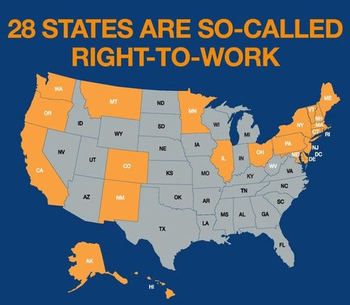
Publisher:
Bonnie King
CONTACT:
Newsroom@Salem-news.com
Advertising:
Adsales@Salem-news.com

~Truth~
~Justice~
~Peace~
TJP
Mar-27-2021 20:29

 TweetFollow @OregonNews
TweetFollow @OregonNews
Democrats: Time to Repeal State Right-to-Work Laws
Ralph E. Stone, Salem-News.com CommentaryThe 1947 Taft-Hartley amendments to the National Labor Relations Act permitted a state to pass so-called right-to-work laws that prohibit unions from requiring a worker to pay dues, even when the worker is covered by a union-negotiated collective bargaining agreement.
 From Laborers' International Union of North America |
(SAN FRANCISCO, Calif.) - On March 9, 2021, the U.S. House of Representatives passed a bipartisan labor bill, the Protecting the Right to Organize (PRO) Act.
One of the bill’s most significant provisions is a repeal of state right-to-work laws that Republican majorities have used to undermine unions, a crucial pro-Democratic constituency, across the country.
That’s why enacting state right-to-work laws or better yet, passing a federal right-to-work law is a top Republican priority.
The 1947 Taft-Hartley amendments to the National Labor Relations Act, permitted a state to pass laws that prohibit unions from requiring a worker to pay dues, even when the worker is covered by a union-negotiated collective bargaining agreement.
Thus, workers in right-to-work states have less incentive to join and pay dues to a union. Unions can still organize in right-to-work states, but they have to convince individual employees that putting roughly 2% of their income toward union dues is worthwhile.
As a result, unions have less clout vis-à-vis corporations. Right-to-work, or as some have called such laws, a right-to-work for less laws, have been enacted by 28 states.
A Bloomberg Law Analysis found workers in right-to-work states compared to non-right-to-work states have lower union membership rates, less work stoppages, and less hourly wages. (According to the U.S. Bureau of Labor Statistics, among full-time wage and salary workers, union members had median usual weekly earnings of $1,144 in 2020, while those who were not union members had median weekly earnings of $958.)
Bloomberg concludes: "The statistics suggest that right-to-work states are succeeding at limiting union strength in terms of membership, organizing, and unrest, but are seeing nonunion workers unable to gain ground on union workers in terms of earnings—even more so than in non-right-to-work states.”
Why do we need unions anyway? Because they are essential for America. Unions are the only large-scale movement left in America that serve as a countervailing balance against corporate power, acting in the economic interest of the middle class. But the decline of unions over the past few decades has left corporations and the rich with essentially no powerful opposition.
You may take issue with a particular union’s position on an issue, but remember they are the only real organized check on the power of the business community in this country.
Thanks to collective bargaining, union members have higher wages and better benefits. In addition, union membership actually raises living and working standards for all working men and women, union and non-union.
When union membership rates are high, so is the share of income that goes to the middle class. When those rates fall, income inequality grows and the middle class shrinks.
Corporations did not all of a sudden give workers two days off each week, which we now call weekends, or paid vacations and sick leave, or rights at the workplace, or pensions, or overtime pay.
Virtually all the benefits we have at work, whether in the public or private sector, are because unions fought hard and long against big business who did everything they could to prevent giving us these rights.
Labor membership is shrinking. According to the Bureau of Labor Statistics, participation in labor unions in 2019 continued their decades-long decline. Union membership in the American workforce was down to 10.3% from 10.5% in 2018.
In 1983, unions represented about 1 out of 5 workers; now it’s 1 in 10 workers. Probably due to the pandemic, however, in 2020, support for union membership is up to 65%.
Right-to-work laws are anti-union and contribute to a shrinking middle class and wealth inequality. Unfortunately, Senate Republicans probably won't support the House PRO Act and will use the filibuster to defeat it.
If Democrats don’t want the PRO Act and the rest of their agenda landing in Senate Minority Leader Mitch McConnell’s legislative graveyard, they will have to bite the bullet and eliminate the Senate filibuster rule.
It is not clear, however, that the Senate Democrats have the 50 votes plus the vice president’s vote to eliminate the filibuster rule; Senators Joe Manchin (D.WV) and Kyrsten Sinema (D.AZ) have defended the filibuster as part of what they assert is a longstanding Senate custom.
The cure for political dysfunction is majority rule. Senate Democrats have work to do to pass the PRO Act.
Articles for March 27, 2021 |


Salem-News.com:
googlec507860f6901db00.html

Quick Links
DINING
Willamette UniversityGoudy Commons Cafe
Dine on the Queen
Willamette Queen Sternwheeler
MUST SEE SALEM
Oregon Capitol ToursCapitol History Gateway
Willamette River Ride
Willamette Queen Sternwheeler
Historic Home Tours:
Deepwood Museum
The Bush House
Gaiety Hollow Garden
AUCTIONS - APPRAISALS
Auction Masters & AppraisalsCONSTRUCTION SERVICES
Roofing and ContractingSheridan, Ore.
ONLINE SHOPPING
Special Occasion DressesAdvertise with Salem-News
Contact:AdSales@Salem-News.com
Terms of Service | Privacy Policy
All comments and messages are approved by people and self promotional links or unacceptable comments are denied.
[Return to Top]
©2025 Salem-News.com. All opinions expressed in this article are those of the author and do not necessarily reflect those of Salem-News.com.